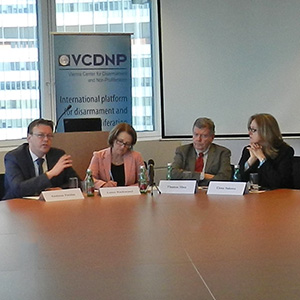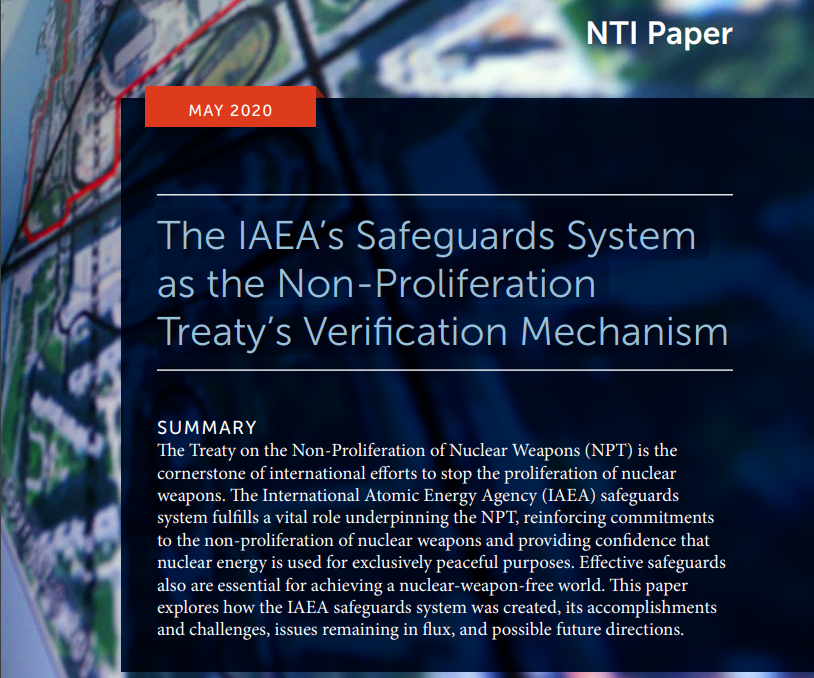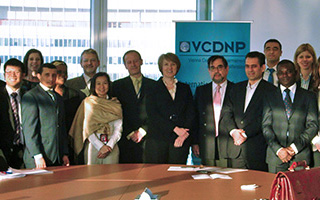
On 13 February 2014, the Vienna Center for Disarmament and Non-Proliferation (VCDNP) and the Verification Research, Training and Information Centre (VERTIC) co-hosted the second seminar in a series on disarmament verification, entitled "Results and Lessons from the Trilateral Initiative on the IAEA Verification of Weapon-Origin Fissile Material," featuring Dr. Thomas Shea, former head of the IAEA Trilateral Initiative Office, and Dr. Laura Rockwood, former principal legal officer and section head for non-proliferation and policy-making in the IAEA Office of Legal Affairs. The seminar was moderated by Elena Sokova, executive director of the VCDNP, and Andreas Persbo, executive director of VERTIC.

Dr. Shea began the seminar with an historical overview of the Trilateral Initiative, which, during its six years of existence (1996-2002), brought together the International Atomic Energy Agency (IAEA), Russia, and the United States, to examine necessary methods and technologies to enable the submission of weapon-origin fissile material to IAEA verification. Whereas unclassified forms of fissile materials could be more readily put under IAEA safeguards as part of each country's Voluntary Offer Agreement (VOA), the Trilateral Initiative would work to enable placing material with classified properties under IAEA safeguards, especially weapon-grade plutonium (plutonium with 93 percent or more of the isotope plutonium-239).
The Trilateral Initiative led to substantive results, one of the most important of which was the development of a method for placing classified weapon-origin plutonium under IAEA verification without revealing proliferation sensitive information. To verify that the declared material was authentic, IAEA inspectors would use attribute verification using neutron-multiplicity and gamma-ray spectrometry (AVNG), whereby an object is compared to a set of reference characteristics, using three attributes—the presence of plutonium, isotopic composition of plutonium, and plutonium mass—all behind information barrier technology. Trilateral Initiative verification envisioned this attribute testing as the first step to placing classified forms of fissile material under safeguards. The verified materials would then be sealed, monitored, taken to a conversion facility, re-verified, converted to unclassified forms in a "black box," and then verified again at the end of the process, when the material was in an agreed upon form—for instance not readily usable for weapons, or rendered practically irrecoverable. Dr. Shea pointed out that one of the unresolved issues examined under the Trilateral Initiative was the problem of instrument authentication—how could one party authenticate equipment built for verification without diminishing the credibility of the equipment for the other parties?

Dr. Rockwood offered an overview of the legal framework of the Trilateral Initiative, pointing out that the IAEA has authorization to carry out verification under such an agreement pursuant to Article III.A.5 of its Statute, and consistently with III.B.1 of the Statute. In the early stages of the Initiative, the parties decided that agreements under the Initiative should take the form of new bi-lateral agreements, instead of being linked to the existing agreements with the IAEA—particularly because the VOAs have fundamentally different objectives and obligations both for the IAEA and the inspected states, and because materials offered under a VOA can be removed at the discretion of the State, while verification under the Trilateral Initiative was envisioned to be irreversible. All parties worked together to develop a Model Verification Agreement for the Trilateral Initiative, which could be used to place any excess weapon-origin material under safeguards. According to Dr. Rockwood, the Trilateral Initiative demonstrated that verification of even classified materials could be accomplished without requiring access by the agency to proliferation sensitive-information, or otherwise risking state security.
Although the final document of the 2000 Review Conference on the Treaty on the Non-Proliferation of Nuclear Weapons called for the completion and implementation of the Trilateral Initiative, by the time of the 2002 IAEA General Conference, the new administrations in the United States and Russia had decided that the Trilateral Initiative should end, concluding that it had been a success and that it was now up to the states to enter into implementation agreements with the IAEA. Such negotiations, however, never took place. Both speakers believed that the Initiative made it possible to conceive how a system for verifying material with classified properties could be established. They saw the closure of the Initiative as a lost opportunity and regretted that the Initiative never moved to the implementation stage.
With regard to the applicability to future disarmament verification, the speakers noted that any nuclear weapon state could decide to proceed with negotiating an implementation agreement with the IAEA based on the Trilateral Initiative Model Verification Agreement. They agreed that the Trilateral Initiative demonstrated both that the IAEA had the authority and capability to carry out verification under such an agreement and that the technical verification difficulties could be overcome. Thus, the Initiative remains relevant today. The tools and concepts developed under the Trilateral Initiative could also be useful for other disarmament efforts involving fissile materials released from weapons programs, including for the implementation of a Fissile Material Cut-Off Treaty, should its negotiation succeed.



